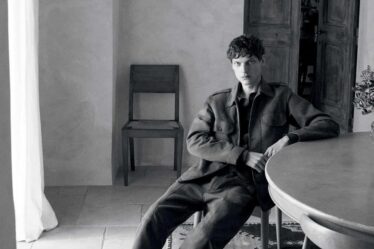
Claire Ratinon and Alice Vincent sit shoulder to shoulder, chatting about recipes for cauliflower, the joys of reversible jackets, and why the heady scent of a house full of paperwhite narcissi is essential for getting through winter.
Despite the chill of the late winter day, the atmosphere of this photoshoot – held in south London’s Bonnington Square Garden – is warm and relaxed. A little way across the Thames from Westminster, this wartime bomb site was turned into a lush community space in the 1990s with the help of designer Dan Pearson. Saturday magazine’s two new gardening columnists punctuate collected moments for the camera with biscuits and gusts of laughter.
Alternating the column between two writers from next weekend (Ratinon will be writing about growing food one week; Vincent will look at cultivating flowers the next) will let us in on a planty dialogue that has been flowing for years. And yet neither woman fits the stereotype of the inveterate gardener who started out sowing and weeding at their parents’ knees: they both felt disconnected from the natural world when growing up, and only discovered the joy of growing in their 20s.
Ratinon, 39, was a documentary producer living in New York in 2012 when a rooftop farm offered an epiphany. Overlooking New York harbour, Brooklyn Grange grows organic vegetables for the people of the city – and the sight of kale and carrots, tomatoes and peppers growing above the urban streets inspired her to consider for the first time the origins of the food we eat.
“I was so captivated by this implausible space in the middle of that huge city, growing amazing, beautiful, delicious, abundant crops,” Ratinon says. She worked as a volunteer there before returning to the UK two years later to continue her gardening education, which included growing food for Yotam Ottolenghi’s plant-focused, central London restaurant Rovi, and working as a school gardener. Today she lives in East Sussex and raises chickens and vegetables on her own patch.
Vincent, 34, grew up in a rural area, but largely ignored the plant world until her mid-20s. She was working as a journalist when she began to hear “quiet murmurings” of people in their 20s and 30s getting into plants. “My way of understanding the world is to research and write about it, so I ended up doing that, honestly not really understanding the difference between an annual and a perennial,” she says.
Moving into a flat with a balcony was her cue to start experimenting with plants, growing herbs for her kitchen: “I remember going to my local library and trying to find books on how to grow in small spaces and there weren’t any; they just assumed you had a massive garden or loads of money or loads of time. I didn’t have any of those things, so I started writing about it and documenting it on Instagram.”
Instagram allowed the two gardeners to connect, although it was meeting in person for the first time at a rain-soaked food festival that cemented their friendship. When hardly anyone turned up to hear them talk about gardening, the pair ended up chatting for hours, eventually moving on to a local pub for further free-ranging discussions.
“We didn’t finish a single conversation,” Vincent says, “and that still happens now.”
Ratinon and Vincent are united in not feeling part of the cosy cliques that beset the gardening world. “Neither of us has ever really felt accepted or comfortable around the horticultural establishment,” Vincent says. “I can pass really well at Chelsea, but at heart I’m still that person who went to the library trying to find out how to grow.
“I still feel like a rookie a lot of the time and I want that to be OK: so many of us garden because it allows us to constantly learn. For me it’s as much about the discovery as the results.”
One of their shared goals for their columns is to expand the idea of what it means to be a gardener or a grower. Ratinon says: “For the longest time, I didn’t have one patch of land that I could devote myself to in a sustained way. I was always working on someone else’s land. There’s a lot of gatekeeping around who gets to call themselves a gardener.”
The climate crisis has added an extra sense of urgency. “We’re in a situation where we can no longer afford to think that gardening is a nicety for people who have the means to dabble in it,” Vincent says. “We have to engage with the world around us because it’s vanishing as we know it. And the only way to save it is to understand what it does for us.”
That might mean challenging our preconceptions about what makes a “beautiful garden”, adds Ratinon. “If the thing you value most is how much your bit of land contributes to the greater ecosystem, the idea of ‘beauty’ becomes something different. We can’t afford to stay stuck in the old ways, because they no longer serve us.”
For Ratinon, harvesting food is the apex of the growing year; feeding others with homegrown produce is her “love language”. Vincent’s realm, meanwhile, is firmly that of flowers. She describes her ultimate gardening moment as getting up at 6.30am on a crisp early-summer morning to enjoy pottering about in her garden in south London.
Neither expects to encroach too far on the other’s growing territory. “To me, it makes sense to divide the column into different areas of expertise,” Vincent says. “I think it’s a rare gardener who does everything really well.”
But they do expect their columns to speak to each other, finding common ground over edible flowers in particular. Both adore nasturtiums – Vincent for their easygoing abundance, Ratinon for the fact that every single part of them is edible.
“I think maybe we should raid each other’s gardens when they’re at their best,” Vincent says. “I can try to make a flower arrangement from Claire’s veg patch, and she can make a salad out of my flowers.”
Their accessible approach should appeal to people who are not sure if gardening is for them. They also intend to sing its wellbeing praises. “Engaging with the ground will make you feel better,” Vincent says, “and if we can make that a bit easier, that’s great.”
Ratinon also hopes their columns will contain moments of levity, “about molehills and being terrorised by badgers,” she says. And the tales and travails of composting will no doubt feature, too.
Vincent recalls the time Ratinon came to fix her malfunctioning, stinky compost heap: “She turned up at my house with a bag full of chicken shit and sawdust.”
“It was medicinal,” says Ratinon, adding that the bag also contained an “inoculation” of material from her own compost heap. “And now,” Vincent adds, “a bit of your garden is in my garden.”
Flowers: Katie Musgrave, unrulyflowers.co.uk. Ceramic cups: Rosamund Coady



